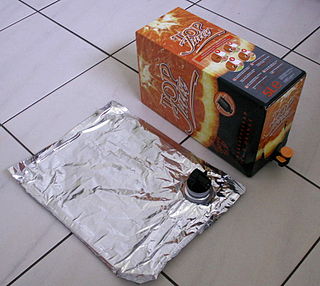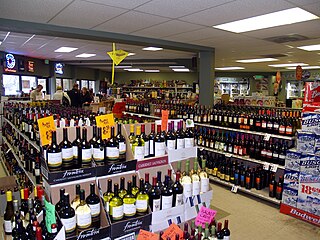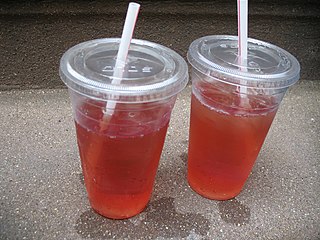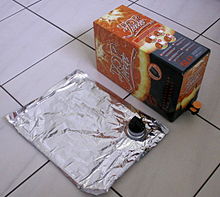
An alcopop is any of certain mixed alcoholic beverages with relatively low alcohol content, including:
- Malt beverages to which various fruit juices or other flavorings have been added
- Wine coolers: beverages containing wine to which ingredients such as fruit juice or other flavorings have been added
- Mixed drinks containing distilled alcohol and sweet liquids such as fruit juices or other flavourings

Sake or saké, also referred to as Japanese rice wine, is an alcoholic beverage of Japanese origin made by fermenting rice that has been polished to remove the bran. Despite the name Japanese rice wine, sake, and indeed any East Asian rice wine, is produced by a brewing process more akin to that of beer, where starch is converted into sugars that ferment into alcohol, whereas in wine, alcohol is produced by fermenting sugar that is naturally present in fruit, typically grapes.

Wine is an alcoholic drink made from fermented fruit. Yeast consumes the sugar in the fruits and converts it to ethanol and carbon dioxide, releasing heat in the process. Though wine can be made from a variety of fruit crops such as plum, cherry, pomegranate, blueberry, currant and elderberry, it is most often made from grapes, and the term "wine" generally refers to grape wine when used without a qualifier.

Whisky or whiskey is a type of liquor made from fermented grain mash. Various grains are used for different varieties, including barley, corn, rye, and wheat. Whisky is typically aged in wooden casks, which are typically made of charred white oak. Uncharred white oak casks previously used for the aging of port, rum or sherry are also sometimes used.

Systembolaget, colloquially known as systemet or bolaget, is a government-owned chain of liquor stores in Sweden. It is the only retail store allowed to sell alcoholic beverages that contain more than 3.5% alcohol by volume. Systembolaget acts as a portal for private companies selling alcohol on the Swedish market and as of 2023, it represents 1,200 vendors ranging from small local breweries to large scale importers and multinational companies, selling products from a total of over 5,000 producers from all over the world.

Winemaking or vinification is the production of wine, starting with the selection of the fruit, its fermentation into alcohol, and the bottling of the finished liquid. The history of wine-making stretches over millennia. There is evidence that suggests that the earliest wine production took place in Georgia and Iran around 6000 to 5000 B.C. The science of wine and winemaking is known as oenology. A winemaker may also be called a vintner. The growing of grapes is viticulture and there are many varieties of grapes.

Calpis, also sold as Calpico, is a Japanese non-carbonated soft drink manufactured by Calpis Co., Ltd., a subsidiary of Asahi Breweries headquartered in Shibuya, Tokyo. The beverage has a light, somewhat milky, and slightly acidic flavour, similar to plain or vanilla-flavoured yogurt or Yakult. Its ingredients include water, dry milk, and lactic acid, and it is produced by lactic acid fermentation.

A bag-in-box or BiB is a container for the storage and transportation of liquids. It consists of a strong bladder, usually made of several layers of metallised film or other plastics, seated inside a corrugated fiberboard box.

Container-deposit legislation is any law that requires the collection of a monetary deposit on beverage containers at the point of sale and/or the payment of refund value to the consumers. When the container is returned to an authorized redemption center, or retailer in some jurisdictions, the deposit is partly or fully refunded to the redeemer. It is a deposit-refund system.

Makgeolli, sometimes anglicized to makkoli, is a Korean alcoholic drink. It is a milky, off-white, and lightly sparkling rice wine that has a slight viscosity, and tastes slightly sweet, tangy, bitter, and astringent. Chalky sediment gives it a cloudy appearance. As a low proof drink of six to nine percent alcohol by volume, it is often considered a "communal beverage" rather than hard liquor.

A liquor store is a retail business that predominantly sells prepackaged alcoholic beverages, including liquors, wine or beer, usually intended to be consumed off the store's premises. Depending on region and local idiom, they may also be called an off-licence, off-sale, bottle shop, bottle store or, colloquially, bottle-o, liquor store or other similar terms. A very limited number of jurisdictions have an alcohol monopoly. In US states that are alcoholic beverage control (ABC) states, the term ABC store may be used.

Jabol is a slang name for a kind of cheap Polish fruit wine that is made from fermented fruit and is bottled at 8% to 18% alcohol by volume. Its name is derived from jabłko, the Polish word for "apple," which it is often made from. Though it is usually fruit flavoured, it can come in other flavours such as chocolate or mint.
Vinmonopolet, symbolized by Ⓥ and colloquially shortened to Polet, is a government-owned alcoholic beverage retailer and the only company allowed to sell beverages containing an alcohol content higher than 4.75% in Norway.

Passion Pop is an Australian alcoholic beverage, labelled as a "Carbonated passion fruit flavoured juice-based beverage". The product was created by Frank “Pop” Miranda in 1977–78 at the C-Sekda winery in Griffith, New South Wales. The rights for the product were then sold to Australian Vintage, who now owns and produces the beverage. It comes in four different flavours: original, mixed berry, pink (strawberry), and watermelon.

A plastic bottle is a bottle constructed from high-density or low density plastic. Plastic bottles are typically used to store liquids such as water, soft drinks, motor oil, cooking oil, medicine, shampoo, milk, and ink. The size ranges from very small bottles to large carboys. Consumer blow molded containers often have integral handles or are shaped to facilitate grasping.

Cider is an alcoholic beverage made from the fermented juice of apples. Cider is widely available in the United Kingdom and Ireland. The UK has the world's highest per capita consumption, as well as the largest cider-producing companies. Ciders from the South West of England are generally higher in alcoholic content. Cider is also popular in many Commonwealth countries, such as India, South Africa, Canada, Australia, and New Zealand. As well as the UK and its former colonies, cider is popular in Portugal, France, Friuli, and northern Spain. Germany also has its own types of cider with Rhineland-Palatinate and Hesse producing a particularly tart version known as Apfelwein. In the U.S. and Canada, varieties of alcoholic cider are often called hard cider to distinguish it from non-alcoholic apple cider or "sweet cider", also made from apples. In Canada, cider cannot contain less than 2.5% or over 13% absolute alcohol by volume.

Plonk is a term used primarily in Commonwealth English for generally cheap, low-quality wine. It is believed to come from Australian slang, in reference to blanc, before it became naturalised in Britain. Despite the reference to the colour white, the term is not limited to white wine, and can as easily indicate a red wine or rosé. In this context, the phrase has even spawned the title of a novel which evokes the perceived tackiness of the 1980s.
This glossary of winemaking terms lists some of terms and definitions involved in making wine, fruit wine, and mead.
The Ontario Deposit Return Program (ODRP), also simply known as Bag it Back, is a regulation of the province of Ontario, Canada. Its purpose is to divert recyclable materials from landfill or low-quality recycling uses by charging a fee for each alcoholic beverage container sold in the province, and processing the material for re-use or other recycling activities once the containers are returned for a refund of the deposit fee. Customers forfeit the deposit fee if the container is not returned.

Goon of Fortune, sometimes called Wheel of Goon, is an Australian drinking game involving cheap cask wine, played between any number of people. The name is a spoof on the TV show Wheel of Fortune.


















